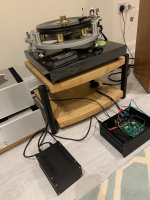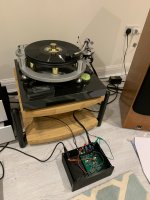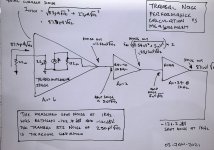I measured 20 ZTX851 and 20 ZTX951’s in circuit for their noise.
They where 20/20 all exactly the same, confirming that Rbb is very stable and indeed resp. 1.5R and 1.2R as AoE also measured.
In the TranBal Hfe and Vbe are IMO not very relevant because the servo’s keep both Ic’s, the most important parameter, constant.
Hans
Hans, thanks. But my question was a general one, not related to the Tranbal.
Thanks jackinnj. Very useful.I am not getting the same CMRR in my pin-board but there are some issues in implementation. Did get the servo to work but there remains a 3.4mV between DC emitter voltages.
Thought you might need this chart: View attachment 1004120
Yes. At the offset voltages under discussion this displacement can be neglected.DC through the coil displaces it from the resting position?
The pickup is not a reciprocal motor in that a DC current of the same magnitude as the signal current flowing through the pickup coil will not cause the cantilever to change its relative position from rest in any way that would affect reproduction. I went back and looked at a few of the posts in the billshurv/LuckyDog/gapapag thread on this where they dissected the issue. Nevertheless, in the interests of perfection and reducing startup current pulses, the input is still be servoed.
Well, it’s up and running with the remote PSU. Ultra quiet, no hiss. I have the system gain switching ok between 1 and 3 but not 1 and 2 - a job for tomorrow. I’m very pleased with the result. Measurements to follow later this week.
Attachments
Very nicely done, thanks for starting this thread. JackI've added a PDF file to the first post with the 1st cut preliminary measurements.
Last pic in the pdf, I think you got the math wrong. Noise adds squarely, so the amp noise is SQRT(798^2-604^2)=520pV/rtHz, nothing to call home about, I’m afraid. Considering the 3dB noise contribution from the diff stage uncorrelated noise halves sources, the single ended stage noise would be 370pV/rtHz, which is larger than I would expect. Implementation or measurement error, I don’t know. Perhaps the gain used to calculate the RTI noise is wrong.
Last edited:
Here is the full TranBal signal chain noise calculation. In summary, the circuit meets its 290 pVrt Hz spec.
You cannot mix voltage and current up in the trans impedance stage - because it’s a current input, all noise voltage sources must be converted into current and then to voltage at the TIS output.
The agreement between measurement and simulation is to within 1 dB at -122 dBV spot noise at 1 kHz which is an excellent result.
You cannot mix voltage and current up in the trans impedance stage - because it’s a current input, all noise voltage sources must be converted into current and then to voltage at the TIS output.
The agreement between measurement and simulation is to within 1 dB at -122 dBV spot noise at 1 kHz which is an excellent result.
Attachments
Don't understand where from you got 87pA/rtHz at the input, how come a transimpedance stage can have Av=6 (I though it should be dimensionally an impedance) and how you get to 11.54nV/rtHz at the TI stage output.
I converted the 22 Ohm thermal noise voltage to thermal current then RMS summed it with the amplifier input resistance thermal current of 3.5 ohms. I then multiplied this by 132 Ohms which is the equivalent TIS collector load (confirmed through sim). This gave 11.54 nV/rt Hz. I RMS summed this with the 5 nV/rt Hz for the bal > singled ended converter and multiplied by 2 to get 25 nV/rt Hz. This was RMS summed with 5 nV/rt Hz for the equivalent input noise to the RIAA stage with gain of 34 at 1 kHz and this gives 871 nV spot noise at 1 kHz or -121.2 dBV at the output. I did not include the system gain stage noise ( 5 nV/rt Hz) because the RMS contribution to input referred noise at this stage is negligible.
Andrew, I didn’t follow your postings in the last few days, but reading your last post I have a few comments.I converted the 22 Ohm thermal noise voltage to thermal current then RMS summed it with the amplifier input resistance thermal current of 3.5 ohms. I then multiplied this by 132 Ohms which is the equivalent TIS collector load (confirmed through sim). This gave 11.54 nV/rt Hz. I RMS summed this with the 5 nV/rt Hz for the bal > singled ended converter and multiplied by 2 to get 25 nV/rt Hz. This was RMS summed with 5 nV/rt Hz for the equivalent input noise to the RIAA stage with gain of 34 at 1 kHz and this gives 871 nV spot noise at 1 kHz or -121.2 dBV at the output. I did not include the system gain stage noise ( 5 nV/rt Hz) because the RMS contribution to input referred noise at this stage is negligible.
The 5nV/rtHz for the Bal>Se is for the complete converter. Now you adding this twice
The other comment is that you are calculating spot noise behind a Riaa amp.
IMO this is not as useful as a figure as the EIN, which is at least a factor two lower and can be used for the S/N calculation contrary to the spot noise.
Hans
Hans, I calculate spot noise at 1 kHz where the gain is flat. This is a good figure of merit and allows instant confirmation of the RTI noise against the sim.Andrew, I didn’t follow your postings in the last few days, but reading your last post I have a few comments.
The 5nV/rtHz for the Bal>Se is for the complete converter. Now you adding this twice
The other comment is that you are calculating spot noise behind a Riaa amp.
IMO this is not as useful as a figure as the EIN, which is at least a factor two lower and can be used for the S/N calculation contrary to the spot noise.
Hans
Sorry, I don’t get your point about the bal> SE converter. Here is how I handled it:- Each opamp is 5 nV/rt Hz, RMS summed this is still 5 nV/rt Hz for both opamp. I ignored the thermal noise of the 220 Ohm gain setting resistors.
For the total integrated noise, you can get this from the sim very easily and also just read it off the QA401. To calculate this means splitting up the audio band, calculating noise for each band then RMS summing it because of the RIAA EQ. A job for a spread sheet - the spot noise method is much easier.
Something is still wrong.
I calculated the whole gain and noise budget and got completely different noise results, see attached.
I think you need a calibrated LNA for measuring the RTI noise for each stage. The Groner thing will do. One problem is that the 22ohm resistor dominates the output noise (0.6nV/rtHz) so the sensitivity of the amplifier RTI measurement is very high (a fraction of dB at the output will change the RTI result significantly). You should try with Rs=5ohm or even lower.
Be very careful with the base decoupling electrolytics. These need to be with extremely low leakage. Otherwise, the leakage will have a noise (like any current) which will get injected straight in the transistors bases, and amplified, screwing the whole noise budget.
I calculated the whole gain and noise budget and got completely different noise results, see attached.
- 22ohm current noise is 600pV/rtHz (noise voltage) divided by 22 ohm = 27pA/rtHz.
- You also got the input stage equivalent schematic wrong, from #169 this is common base, not common emitter, see the attachment for the right equivalent topology.
- You should get about 450pV/rtHz at the full amp output to match the calculation, you got 871.
- Av=6 for the first (low noise) stage is correct as a voltage gain, but otherwise you got the noise budget wrong.
I think you need a calibrated LNA for measuring the RTI noise for each stage. The Groner thing will do. One problem is that the 22ohm resistor dominates the output noise (0.6nV/rtHz) so the sensitivity of the amplifier RTI measurement is very high (a fraction of dB at the output will change the RTI result significantly). You should try with Rs=5ohm or even lower.
Be very careful with the base decoupling electrolytics. These need to be with extremely low leakage. Otherwise, the leakage will have a noise (like any current) which will get injected straight in the transistors bases, and amplified, screwing the whole noise budget.
Attachments
Last edited:
I got a reading of c. -121.4 dBV on the output and my noise calculation supports that. The complete signal chain sim also supports the -121.4 dBV figure. The front end stage (TIS + bal to SE) sim gives 292pV/rt Hz which is what I used to calculate up to the output.
How are we getting a difference of 158 pV/rt Hz?
(Point on the base decoupling electrolytics taken - not seeing an issue now but Hans has some experience with this type of problem as well)
How are we getting a difference of 158 pV/rt Hz?
(Point on the base decoupling electrolytics taken - not seeing an issue now but Hans has some experience with this type of problem as well)
Last edited:
- Home
- Source & Line
- Analogue Source
- Low noise Balanced MC Pre





